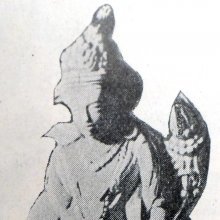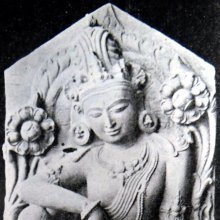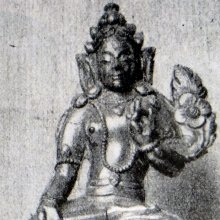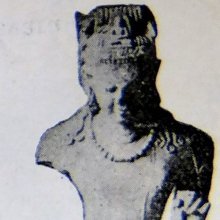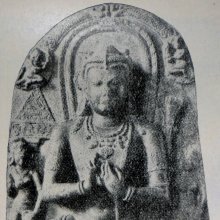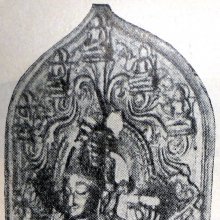Paryanka, Paryaṅka, Paryamka: 22 definitions
Introduction:
Paryanka means something in Buddhism, Pali, Hinduism, Sanskrit, Jainism, Prakrit, Marathi. If you want to know the exact meaning, history, etymology or English translation of this term then check out the descriptions on this page. Add your comment or reference to a book if you want to contribute to this summary article.
Images (photo gallery)
(+7 more images available)
In Hinduism
Purana and Itihasa (epic history)
Source: archive.org: Shiva Purana - English TranslationParyaṅka (पर्यङ्क) refers to a “cushioned couch”, according to the Śivapurāṇa 2.5.5 (“The Tripuras are fascinated).—Accordingly, as Arihan said to the Lord of the Three Cities: “O ruler of the Asuras, listen to my statement, pregnant with wisdom. It is the essence of the Vedānta and bears high esoteric importance. [...] Let there be hundreds of horses, of different varieties. But for the purpose of riding only one can be used on one occasion. The pleasure that one derives in that sleep on a cushioned couch (paryaṅkaśāyin) is the same that one derives by sleeping on the bare ground. Just as we, the embodied beings, are afraid of death so also the bodies from Brahmā to the worm are afraid of death. [...]”.
Source: Cologne Digital Sanskrit Dictionaries: The Purana IndexParyaṅka (पर्यङ्क).—1000 hooded serpent shedding golden lustre as bed of the Lord.*
- * Vāyu-purāṇa 24. 11, 17.

The Purana (पुराण, purāṇas) refers to Sanskrit literature preserving ancient India’s vast cultural history, including historical legends, religious ceremonies, various arts and sciences. The eighteen mahapuranas total over 400,000 shlokas (metrical couplets) and date to at least several centuries BCE.
Shaktism (Shakta philosophy)
Source: Google Books: ManthanabhairavatantramParyaṅka (पर्यङ्क) refers to a “cot” [“couch”?], according to the Śrīmatottara-tantra, an expansion of the Kubjikāmatatantra: the earliest popular and most authoritative Tantra of the Kubjikā cult.—Accordingly, while describing the Mūrti (visualized iconic form) of the goddess Mālinī: “She is like the rising sun and is blissful with wine. Very beautiful, she has five faces and is radiant with five time three eyes. [...] Three wrinkles (adorn her) middle part and she has large, upraised breasts. She has a necklace and bracelets adorned with jewels and gems. The goddess sits in the adamantine posture on a cot [i.e., preta-paryaṅka-saṃsthitā]. She wears a garland of vowels on her head and a divine necklace of letters around her neck”.
Source: Brill: Śaivism and the Tantric Traditions (shaktism)Paryaṅka (पर्यङ्क) refers to “seats” (e.g., ‘she who is furnished with seats and pillows’), according to the King Vatsarāja’s Pūjāstuti called the Kāmasiddhistuti (also Vāmakeśvarīstuti), guiding one through the worship of the Goddess Nityā.—Accordingly, “[...] She is elegantly seated on a lofty couch studded with jewels, furnished with seats (paryaṅka) and pillows, and decorated with a canopy of pearls. Her face is a fully developed lotus. She has a row of chowries being shaken around her, and her beaming lotus-face surpasses beautiful lotuses. [...]”.

Shakta (शाक्त, śākta) or Shaktism (śāktism) represents a tradition of Hinduism where the Goddess (Devi) is revered and worshipped. Shakta literature includes a range of scriptures, including various Agamas and Tantras, although its roots may be traced back to the Vedas.
General definition (in Hinduism)
Source: Wisdom Library: HinduismParyaṅka (पर्यङ्क) is a Sanskrit word referring to a “couch” or “sofa”.
In Buddhism
Tibetan Buddhism (Vajrayana or tantric Buddhism)
Source: OSU Press: Cakrasamvara SamadhiParyaṅka (पर्यङ्क) is the name of a sitting posture for meditation, and is used to describe Vajravārāhī, according to the Saṃvaramaṇḍala of Abhayākaragupta’s Niṣpannayogāvalī, p. 45 and n. 145; (Cf. Cakrasaṃvaratantra, Gray, David B., 2007).—Vajravārāhī appears both with Cakrasaṃvara, and on her own, both as Vajravārāhī and Vajrayoginī. On her own as Vajravārāhī she appears dancing in half paryaṅka, (ardhaparyaṅka-nṛtyā) the most common posture for Ḍākinīs. Paryaṅka is a common sitting posture for meditation, where the bent knees point forward, feet point back, with hamstrings resting on the calves. Dancing in half paryaṅka, is a standing posture, where one leg is lifted in ardhaparyaṅka, and the other is on the ground, indicating a joyous and passionate Buddha nature. [...]

Tibetan Buddhism includes schools such as Nyingma, Kadampa, Kagyu and Gelug. Their primary canon of literature is divided in two broad categories: The Kangyur, which consists of Buddha’s words, and the Tengyur, which includes commentaries from various sources. Esotericism and tantra techniques (vajrayāna) are collected indepently.
Mahayana (major branch of Buddhism)
Source: De Gruyter: A Buddhist Ritual Manual on AgricultureParyaṅka (पर्यङ्क) refers to “(being seated) cross-legged”, according to the Vajratuṇḍasamayakalparāja, an ancient Buddhist ritual manual on agriculture from the 5th-century (or earlier), containing various instructions for the Sangha to provide agriculture-related services to laypeople including rain-making, weather control and crop protection.—Accordingly, [as the Bhagavān teaches the offering of the root spell], “[...] Having taken brownish cow dung that has not touched the ground and taking ghee, milk and cow urine, one should mix it with seven seeds and flour. Having enchanted it ninety times with that mantra, a five-headed Nāga should be made. It should be hooded with jewels, seated cross-legged (baddha-paryaṅka), coiled, and having smeared it with white sandal and saffron, it should be placed on a pure seat. [...]”.

Mahayana (महायान, mahāyāna) is a major branch of Buddhism focusing on the path of a Bodhisattva (spiritual aspirants/ enlightened beings). Extant literature is vast and primarely composed in the Sanskrit language. There are many sūtras of which some of the earliest are the various Prajñāpāramitā sūtras.
In Jainism
General definition (in Jainism)
Source: archive.org: The Jaina IconographyParyaṅka (पर्यङ्क) or Saṃparyaṅka refers to one of the various āsanas (postures) commonly depcited in Jain iconography.—Glossed as Padmāsana, which, in the Jaina Yogic texts, is described as a posture in which the Jaina or any devotee squats on a seat with legs folded, the right leg being on the left thigh and the left leg on the right thigh, while the eyes are fixed upon the tip of the nose. The position of the arms varies. There is a religious prescription to the effect that the image of Mahāvīra, Ṛṣabhanātha and Neminātha should be constructed in this posture or Āsana. The extant sculptures of the Tīrthaṃkaras mentioned do not always support the injunction.
Source: archive.org: TrisastisalakapurusacaritraParyaṅka (पर्यङ्क) or Paryaṅkāsana is the name of a posture (āsana), according to chapter 2.1 [ajitanātha-caritra] of Hemacandra’s 11th century Triṣaṣṭiśalākāpuruṣacaritra: an ancient Sanskrit epic poem narrating the history and legends of sixty-three illustrious persons in Jainism.—Note: Paryaṅka refers to the posture of the seated statues of Jinas. The legs are crossed so the foot of one lies on the other about the knee, with the sole up. The hands are held at the waist, the right oh top of the left, with the palms up.—(cf. Yogaśāstra 4.125)
Accordingly, “the elephant of kings (i.e., Vimalavāhana) dismounted from the elephant’s shoulder and entered the garden, like a lion a mountain-cave. [...] He saw monks there, too, some in the [viz., paryaṅka-posture, ...] some engaged in kāyotsarga, and some in ukṣa-posture, indifferent to the body, who had carried out their vows in the midst of numerous attacks, like soldiers in battles, victorious over internal enemies, enduring trials, powerful from penance and meditation [...] The King, with devotion sprouted in the guise of horripilation, as it were, approached Ācārya Arindama and paid homage to him”.
Source: The University of Sydney: A study of the Twelve ReflectionsParyaṅka (पर्यङ्क) refers to “sitting cross-legged”, according to the 11th century Jñānārṇava, a treatise on Jain Yoga in roughly 2200 Sanskrit verses composed by Śubhacandra.—Accordingly, “On a flat piece of wood or stone, on the ground or on sandy soil, the wise [person] should adopt a stable posture for the accomplishment of absorption. Thus, sitting cross-legged (paryaṅka), sitting half cross-legged, thunderbolt, hero posture and the previously mentioned pleasant and lotus [postures] as well as abandonment of the body is highly thought of. [...]”.

Jainism is an Indian religion of Dharma whose doctrine revolves around harmlessness (ahimsa) towards every living being. The two major branches (Digambara and Svetambara) of Jainism stimulate self-control (or, shramana, ‘self-reliance’) and spiritual development through a path of peace for the soul to progess to the ultimate goal.
Languages of India and abroad
Marathi-English dictionary
Source: DDSA: The Molesworth Marathi and English Dictionaryparyaṅka (पर्यंक).—m S A bedstead, couch, cot.
Source: DDSA: The Aryabhusan school dictionary, Marathi-Englishparyaṅka (पर्यंक).—m A bedstead. couch.
Marathi is an Indo-European language having over 70 million native speakers people in (predominantly) Maharashtra India. Marathi, like many other Indo-Aryan languages, evolved from early forms of Prakrit, which itself is a subset of Sanskrit, one of the most ancient languages of the world.
Sanskrit dictionary
Source: DDSA: The practical Sanskrit-English dictionaryParyaṅka (पर्यङ्क).—
1) A bed, couch, sofa; क्वचिद् भूमौ शायी क्वचिदपि च पर्यङ्कशयनः (kvacid bhūmau śāyī kvacidapi ca paryaṅkaśayanaḥ) Bhartṛhari 2.81.
2) A palanquin.
3) A cloth girt round the back, loins, and knees (by a person) when sitting on his hams; cf. अवसक्थिका (avasakthikā)
6) A particular kind of posture practised by ascetics in meditation, sitting on the hams; it is the same as वीरासन (vīrāsana) which is thus defined by Vasiṣṭha :-एकं पादमथैकस्मिन् विन्यस्योरौ तु संस्थितं । इतरस्मिंस्तथैवोरुं वीरासनमुदाहृतम् ॥ पर्यङ्क- ग्रन्थिबन्ध (ekaṃ pādamathaikasmin vinyasyorau tu saṃsthitaṃ | itarasmiṃstathaivoruṃ vīrāsanamudāhṛtam || paryaṅka- granthibandha) &c. Mṛcchakaṭika 1.1.
Derivable forms: paryaṅkaḥ (पर्यङ्कः).
Source: Cologne Digital Sanskrit Dictionaries: Shabda-Sagara Sanskrit-English DictionaryParyaṅka (पर्यङ्क) or Paryyaṅka or Palyaṅka.—m.
(-ṅkaḥ) 1. A bed. 2. A cloth thrown over the back, loins, and kneels, while seated upon the hams. The posture is thus described on Vachaspatya, viz:— ekaṃ pādamathaikasmin vinyasyorau tu maṃsthitam . itarasmin tathaivorddhaṃ vīrāsana midaṃ smṛtam .. uttānite karatale pharamuttānitaṃ param . ādhāyāṅka gataṃ kṛtvā dhyāyedyastasya so'ntaram .. E. pari about, aki to go, aff. ac; also ra being optionally changed to la, palyaṅka.
Source: Cologne Digital Sanskrit Dictionaries: Benfey Sanskrit-English DictionaryParyaṅka (पर्यङ्क).—i. e. pari-aṅka, m. 1. A couch-bed, a bed, [Pañcatantra] i. [distich] 190. 2. Sitting on one’s legs in the oriental manner, [Kumārasaṃbhava, (ed. Stenzler.)] 3, 45.
Source: Cologne Digital Sanskrit Dictionaries: Cappeller Sanskrit-English DictionaryParyaṅka (पर्यङ्क).—[masculine] couch, bed; the sitting with bent legs upon the hams.
Source: Cologne Digital Sanskrit Dictionaries: Monier-Williams Sanskrit-English Dictionary1) Paryaṅka (पर्यङ्क):—[=pary-aṅka] [from pary-añc] m. (also paly, [Pāṇini 8-2, 22]) a bed, couch, sofa, litter, palanquin, [Kauṣītaki-upaniṣad; Mahābhārata; Kāvya literature] etc. (also kikā f., [Kādambarī]; kī-kṛta mfn. turned into a couch, [Gīta-govinda])
2) [v.s. ...] a [particular] mode of sitting on the ground (a squatting position assumed by ascetics and Buddhists in meditation), [Buddhist literature] (cf. below)
3) [v.s. ...] a cloth wound round the back and loins and knees while so sitting, [cf. Lexicographers, esp. such as amarasiṃha, halāyudha, hemacandra, etc.]
4) [v.s. ...] Name of a mountain (son of Vindhya), [cf. Lexicographers, esp. such as amarasiṃha, halāyudha, hemacandra, etc.]
Source: Cologne Digital Sanskrit Dictionaries: Yates Sanskrit-English DictionaryParyaṅka (पर्यङ्क):—[parya-ṅka] (ṅkaḥ) 1. m. A bed; a couch.
Source: DDSA: Paia-sadda-mahannavo; a comprehensive Prakrit Hindi dictionary (S)Paryaṅka (पर्यङ्क) in the Sanskrit language is related to the Prakrit words: Paliaṃka, Paliaṃkā.
[Sanskrit to German]
Sanskrit, also spelled संस्कृतम् (saṃskṛtam), is an ancient language of India commonly seen as the grandmother of the Indo-European language family (even English!). Closely allied with Prakrit and Pali, Sanskrit is more exhaustive in both grammar and terms and has the most extensive collection of literature in the world, greatly surpassing its sister-languages Greek and Latin.
Kannada-English dictionary
Source: Alar: Kannada-English corpusParyaṃka (ಪರ್ಯಂಕ):—
1) [noun] a piece of furniture with four legs, a flat, rectangular top to lay the bed and sleep on; a cot.
2) [noun] a box-type rectangular cloth case filled with cotton, coir, feathers, down, foam, rubber, etc. used to sleep on; a bed.
3) [noun] a passenger conveyance, usu. for one person, consisting of a covered or boxlike litter carried by means of poles resting on the shoulders of several men; a palanquin.
4) [noun] an oblong, unstitched piece of cloth, used to tie around the waist.
5) [noun] the place of protection; shelter; refuge.
6) [noun] a yogic posture of squating on the floor with the shanks crossing each other and the right foot resting on the left thigh and leftfoot on the right thigh.
Kannada is a Dravidian language (as opposed to the Indo-European language family) mainly spoken in the southwestern region of India.
See also (Relevant definitions)
Partial matches: Pary, Parya, Nka, Anka.
Starts with: Paryankabaddha, Paryankabandha, Paryankabandhana, Paryankabhogin, Paryankagranthi, Paryankagranthibandha, Paryankamudra, Paryankapadika, Paryankapattika, Paryankasadana, Paryankasana, Paryankashaucavidhi, Paryankashayin, Paryankastha.
Ends with: Ardhaparyanka, Baddhaparyanka, Nagaparyanka, Pretaparyanka, Ratnaparyanka, Samparyanka.
Full-text (+73): Paryankasana, Palyanka, Paliamka, Paryankabandhana, Paryastika, Paryankabhogin, Paryankabaddha, Paryankabandha, Ardhaparyanka, Paryasti, Paryankastha, Paryankapattika, Paryankapadika, Paryankagranthibandha, Virasana, Paryankika, Paryankikrita, Amitaujas, Abhuj, Paryamka.
Relevant text
Search found 27 books and stories containing Paryanka, Paryaṅka, Paryamka, Pary-anka, Pary-aṅka, Parya-nka, Parya-ṅka, Paryaṅkā, Paryaṃka; (plurals include: Paryankas, Paryaṅkas, Paryamkas, ankas, aṅkas, nkas, ṅkas, Paryaṅkās, Paryaṃkas). You can also click to the full overview containing English textual excerpts. Below are direct links for the most relevant articles:
Maha Prajnaparamita Sastra (by Gelongma Karma Migme Chödrön)
Part 4 - Filling all of space < [Chapter XLIX - The Four Conditions]
Act 10.5: The bodhisattvas sitting cross-legged preaching the six virtues < [Chapter XV - The Arrival of the Bodhisattvas of the Ten Directions]
I. Becoming buddha and preaching the dharma the same day < [Part 13 - Carrying out abhisaṃbodhi, preaching and conversions all in the same day]
Yoga-sutras (with Vyasa and Vachaspati Mishra) (by Rama Prasada)
Sūtra 2.46 < [Book 2 - Practice (Sādhana)]
Brahma Sutras (Shankaracharya) (by George Thibaut)
III, 3, 30 < [Third Adhyāya, Third Pāda]
III, 3, 27 < [Third Adhyāya, Third Pāda]
III, 3, 31 < [Third Adhyāya, Third Pāda]
Tiruvaymoli (Thiruvaimozhi): English translation (by S. Satyamurthi Ayyangar)
Pasuram 8.7.11 < [Section 7 - Seventh Tiruvaymoli (Iruttum, viyantu)]
Trishashti Shalaka Purusha Caritra (by Helen M. Johnson)
Notes on Āsana (postures) < [Notes]
Part 15: Ajita’s mokṣa < [Chapter VI - Emancipation of Ajita Svāmin and Sagara]
Part 16: Ṛṣabha’s nirvāṇa < [Chapter VI]
The Indian Buddhist Iconography (by Benoytosh Bhattachacharyya)
